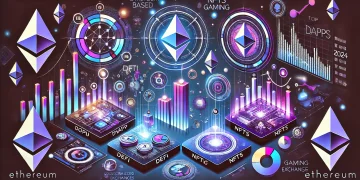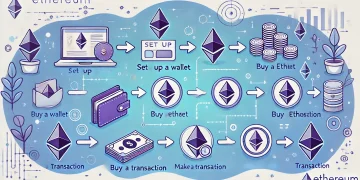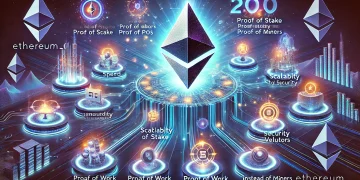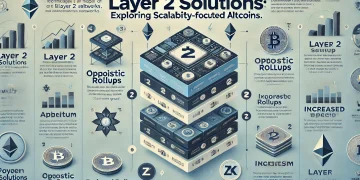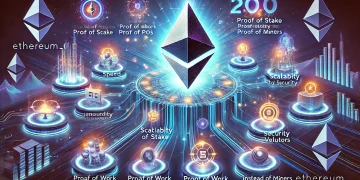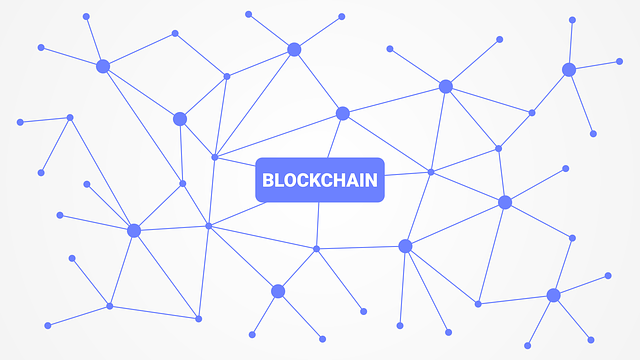Blockchain technology is transforming the way data is stored, verified, and transferred across various industries. While much of the focus tends to be on the cryptocurrencies or applications built on top of blockchain networks, the foundation of blockchain technology itself lies in its nodes. A node is a fundamental component of a blockchain network, responsible for maintaining the security, transparency, and functionality of the entire system.
This comprehensive guide will introduce you to blockchain nodes, explain how they work, and why they are essential for the stability and security of decentralized networks.
1. What is a Blockchain Node?
A blockchain node is any device that connects to a blockchain network to support and validate the network. Nodes are responsible for storing a complete or partial copy of the blockchain’s transaction history, verifying transactions, and communicating with other nodes to maintain a decentralized system. Essentially, nodes keep the network functioning by enabling data sharing across the network without requiring a centralized authority.
Different Types of Nodes
There are several types of nodes in blockchain networks, each with its unique function and purpose:
- Full Nodes: These nodes store a complete copy of the blockchain and validate every transaction and block. Full nodes play a crucial role in ensuring the security and integrity of the network.
- Light Nodes (or Lightweight Nodes): Light nodes don’t store the entire blockchain; instead, they store a portion of it. They rely on full nodes to access and verify transactions and are commonly used in mobile applications.
- Mining Nodes: Mining nodes are used in Proof of Work (PoW) blockchains like Bitcoin to solve complex puzzles and validate transactions. These nodes contribute computational power to add new blocks to the blockchain.
- Validator Nodes: Found in Proof of Stake (PoS) networks, validator nodes are chosen to verify transactions and maintain the network’s integrity. Unlike mining nodes, they don’t require high computational power, making PoS networks more energy-efficient.
2. The Role of Nodes in a Blockchain Network
Nodes perform several critical functions that enable a blockchain network to operate securely and efficiently. Here are some of the main roles nodes play:
a. Transaction Verification
Each transaction on a blockchain network is processed by nodes to verify its authenticity. When a transaction is initiated, it is broadcast to all nodes in the network. The nodes then validate the transaction based on predefined rules, such as ensuring that the sender has sufficient funds or that there are no double-spending issues.
b. Storing the Blockchain’s Transaction History
Nodes act as storage points for blockchain data. Every time a new block is added, it is distributed across nodes, creating a decentralized ledger that is accessible to all. Full nodes, in particular, store the complete transaction history, which can be several hundred gigabytes in size for popular blockchains like Bitcoin or Ethereum.
c. Decentralization and Security
Nodes eliminate the need for a central authority, ensuring the blockchain’s decentralized nature. Each node operates independently, yet all nodes work together to reach a consensus on the current state of the blockchain. This redundancy makes the network secure, as a successful attack would require compromising more than half of the nodes (known as a 51% attack).
d. Communication and Consensus
Nodes communicate with each other to reach an agreement, or consensus, on the network’s state. By sharing information and verifying transactions, nodes collectively ensure the blockchain’s consistency. Consensus mechanisms like Proof of Work (PoW) or Proof of Stake (PoS) guide nodes in maintaining an accurate ledger.
3. Types of Blockchain Nodes in Detail
Blockchain nodes vary in function, structure, and operational requirements. Here’s a more in-depth look at the different types of nodes commonly used in blockchain networks.
a. Full Nodes
Full nodes are the backbone of a blockchain network. They store the entire transaction history and enforce the network’s rules, making them critical for maintaining security and consensus.
- Storage requirements: Full nodes require substantial storage, often hundreds of gigabytes, as they store a complete copy of the blockchain.
- Data integrity: Full nodes validate each transaction, reject fraudulent data, and ensure the blockchain’s accuracy.
- Examples: Most full nodes are used by large exchanges or blockchain organizations to verify all transactions on the network.
b. Light Nodes (Lightweight Nodes)
Light nodes only store a portion of the blockchain data, typically the block headers. This makes them more accessible for mobile devices and computers with limited storage.
- Usage: Light nodes are often used by wallets, mobile applications, and individual users who need access to blockchain data without requiring extensive storage.
- Dependency: Light nodes depend on full nodes to access detailed transaction data.
- Efficiency: They offer quick access to blockchain data and are essential for end-users needing to verify transactions on the go.
c. Mining Nodes
Mining nodes perform the heavy computational work in Proof of Work (PoW) networks, such as Bitcoin. They solve complex cryptographic puzzles to validate transactions and add blocks to the blockchain.
- Requirements: Mining nodes require powerful hardware, such as ASICs (Application-Specific Integrated Circuits) or GPUs, and significant electricity.
- Mining rewards: Miners are rewarded with newly minted coins and transaction fees, which incentivizes them to maintain the network.
- Security: Mining nodes play a key role in securing PoW networks by adding blocks only after solving complex puzzles, which deters malicious actors.
d. Validator Nodes
In Proof of Stake (PoS) and other consensus mechanisms that don’t rely on mining, validator nodes are responsible for verifying and adding transactions to the blockchain.
- Staking: Validator nodes require users to lock up, or “stake,” a certain amount of cryptocurrency as collateral, which can be forfeited in case of malicious behavior.
- Energy efficiency: Validator nodes do not require heavy computational power, making PoS networks more environmentally friendly.
- Incentives: Validators earn rewards based on the amount they have staked, encouraging them to act in the network’s best interest.
4. How Nodes Support Consensus Mechanisms
In a blockchain network, consensus mechanisms are protocols that allow nodes to agree on the network’s current state. These mechanisms prevent fraud and ensure that every transaction added to the blockchain is valid.
a. Proof of Work (PoW)
Proof of Work is the consensus mechanism used by Bitcoin and other PoW-based blockchains. In PoW, miners (mining nodes) compete to solve complex cryptographic puzzles. The first miner to solve the puzzle adds a new block to the blockchain and is rewarded with cryptocurrency.
- Security: PoW is highly secure, but it requires significant computational power.
- Energy consumption: PoW is energy-intensive, leading to concerns about its environmental impact.
- Double-spending prevention: PoW’s difficulty makes it challenging to alter transaction history, ensuring data integrity.
b. Proof of Stake (PoS)
Proof of Stake is a consensus mechanism where validators (validator nodes) are chosen to validate transactions based on the amount of cryptocurrency they hold and are willing to stake.
- Energy efficiency: PoS requires minimal computational power, reducing environmental impact.
- Incentives: Validators earn rewards based on their staked amount, making it financially unattractive to act maliciously.
- Security: PoS is considered less susceptible to 51% attacks compared to PoW due to the financial commitment required.
c. Delegated Proof of Stake (DPoS)
Delegated Proof of Stake is a variation of PoS where stakeholders elect a small group of validators to secure the network.
- Election process: Token holders vote for delegates, who then take turns validating transactions.
- Scalability: DPoS improves scalability by reducing the number of active validators, making it suitable for high-transaction networks.
- Governance: DPoS allows token holders to have a say in network governance, adding a democratic element.
5. Setting Up a Blockchain Node
Setting up a node varies depending on the blockchain network, node type, and desired purpose (e.g., full node, light node). Here’s a basic overview of what it entails.
a. Hardware Requirements
Different types of nodes have different hardware requirements. For example:
- Full Nodes: Require substantial storage (500GB+ for networks like Bitcoin) and a stable internet connection.
- Light Nodes: Minimal hardware is needed, making them suitable for mobile or desktop applications.
- Mining Nodes: Demand powerful hardware, such as ASICs or GPUs, and high electricity consumption.
b. Software Installation
To set up a node, users typically need to download the blockchain’s client software:
- Bitcoin Core: For Bitcoin full nodes, users can download Bitcoin Core, which contains the entire transaction history.
- Ethereum Geth: For Ethereum, the Go Ethereum (Geth) client is used for syncing with the Ethereum blockchain.
- Lite clients: Many blockchains offer lite clients for lightweight nodes that connect to full nodes for data retrieval.
c. Configuration and Syncing
Once the software is installed, the node will start syncing with the blockchain. This process can take anywhere from a few hours to several days, depending on the network’s size and the node type.
6. Advantages and Challenges of Running a Node
Running a blockchain node offers several benefits but also comes with its share of challenges.
Advantages
- Privacy and autonomy: Running a full node allows users to interact with the blockchain without relying on third-party services.
- Network security: By running a node, users contribute to the network’s decentralization and security.
- Direct access to data: Nodes have a direct connection to blockchain data, which is valuable for developers or researchers.
Challenges
- High storage and bandwidth requirements: Running a full node requires substantial hardware, storage, and bandwidth, which can be costly.
- Technical expertise: Setting up and maintaining a node requires a certain level of technical skill.
- Energy consumption: Mining nodes, in particular, consume high amounts of energy, leading to environmental and cost concerns.
7. The Importance of Nodes for Decentralization
Nodes are essential for maintaining a blockchain network’s decentralized nature. Unlike traditional systems, where a single authority controls data, blockchain nodes share control among numerous participants, making it nearly impossible for a single entity to manipulate the data.
a. Decentralized Governance
Blockchain nodes enable decentralized governance by ensuring no single entity has control over the network. Each node has equal access to data and decision-making, preserving the democratic nature of blockchain.
b. Resilience Against Attacks
With nodes distributed globally, blockchain networks are resilient to censorship and attacks. For example, to alter data on the Bitcoin blockchain, a bad actor would need to compromise over half of the network’s nodes, which is logistically and economically unfeasible.
8. Nodes and Blockchain Scaling Solutions
Blockchain networks face challenges with scalability, especially when user demand grows. Nodes play a critical role in supporting scaling solutions:
a. Layer 2 Solutions
Layer 2 solutions like the Lightning Network for Bitcoin or Polygon for Ethereum allow transactions to be processed off-chain while recording the final data on the main blockchain. Nodes in these layer 2 networks are used to facilitate quick transactions without overloading the main network.
b. Sharding
Sharding is a technique that divides a blockchain into smaller parts, or “shards,” each of which is managed by a subset of nodes. This allows the network to process more transactions simultaneously.
c. Rollups
Rollups are a solution where multiple transactions are bundled together off-chain and then submitted to the main blockchain as a single transaction, reducing the burden on full nodes and improving transaction speed.
9. Future of Blockchain Nodes
As blockchain technology evolves, nodes will continue to play a pivotal role in supporting new use cases, improving scalability, and enhancing security.
a. Cloud-Based Nodes
The rise of cloud-based nodes allows users to participate in blockchain networks without hosting hardware, making it easier and more affordable to run a node.
b. Light Clients and Mobile Nodes
Light clients are becoming more efficient, allowing users to access blockchain networks from mobile devices while still maintaining data integrity.
c. Increased Interoperability
Future blockchain networks will likely prioritize interoperability, enabling nodes on different blockchains to communicate with each other, facilitating a more connected ecosystem.
Conclusion: Nodes as the Backbone of Blockchain
Blockchain nodes are the foundational infrastructure of decentralized networks, supporting everything from transaction verification to data storage. By understanding the role of nodes, their types, and their importance to decentralization, you gain a deeper appreciation for the mechanics that keep blockchain networks secure, transparent, and resilient.
Whether you’re interested in running a node or simply understanding how blockchain works, knowing the ins and outs of nodes is essential for anyone exploring the world of blockchain technology.

